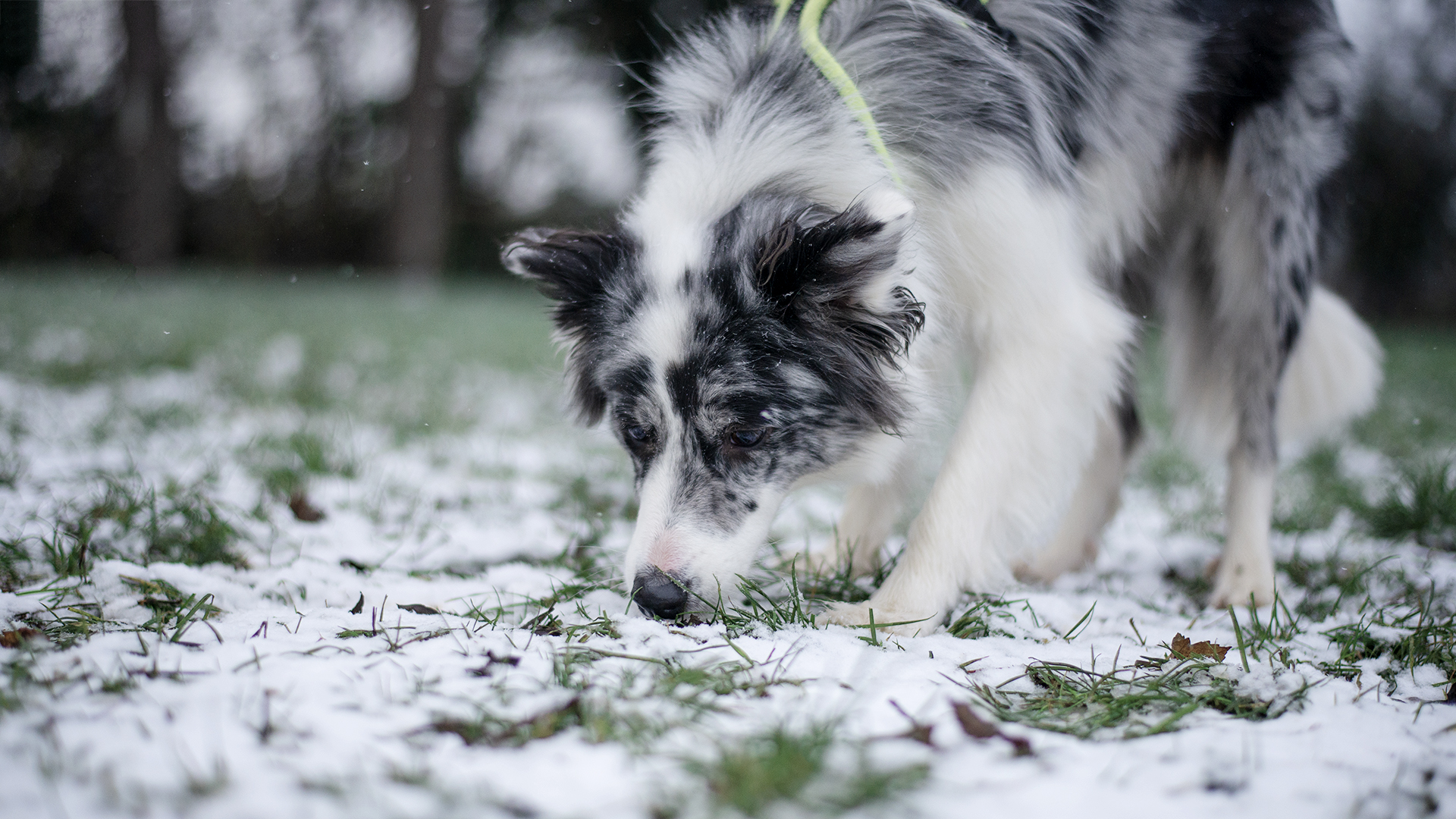I tried a 45-minute 'sniffari', and it tired out my border collie more than a two-hour hike!
Want to calm your dog and tire it out at the same time? A sniffari could be the answer

This will likely come as a surprise to approximately nobody, but my 18-month-old border collie is a pretty high energy dog. Common advice for dogs with a high drive is to find them a ‘job’ to do, such as agility training, trick training, or even simply playing retrieve games. While these are all great suggestions (and I’ve pretty much tried them all!), high energy activities can leave my border collie Fenwick overly stimulated and wired, rather than simply just tiring her out.
Unfortunately, Fenwick’s high drive also goes hand-in-hand with a nervousness and sensitivity that’s genetic (and particularly common in border collies). Combined with a bad food allergy that prevented as much socialization as I’d have liked in her puppy months (although the allergy symptoms vastly improved when we switched her over to one of the best dog foods for allergies on vet advice), Fenwick is prone to becoming overwhelmed if too much is asked of her.
In order to help her be the best dog she can be, I decided that I needed to find a holy grail of an activity that could both tire her out and calm her down. Luckily, the answer was easier than I thought. Scentwork can not only be a calming activity, but it’s also very brain-intensive as well.
I asked Lara Sorisi, an APDT-certified dog trainer and a certified UK Sniffer Dogs Instructor, why scentwork tires dogs out so much. She says, “it uses such a large part of their brain and it’s a great way to give them a job to do. I always tell clients that most dogs are ‘unemployed’, but all dogs were designed to do a purpose. If you give your dog targeted scenting, or even just allow them the time to explore the scents they naturally find, your dogs will get a fantastic amount of mental stimulation and they’ll go home a lot more tired.”
When our lives are so busy, it can be tempting to try to pack as much exercise as possible into the period of time that we’ve allotted to our dogs. However, while marching them on a walk around the block might be physically tiring, it might not provide much mental stimulation for many dogs. Alternatively, if they have a nervous disposition, they might swing the other way and become stressed from traveling through lots of new environments. So, rather than take Fenwick on a two-hour hike that will leave her over-stimulated at the end from all of the dogs, people, and cars that she’s encountered, I decided to try a 45-minute “sniffari” instead.

Lara Sorisi is a science-based and force-free dog trainer that has been training dogs for six years. She is accredited by the APDT (Association of Pet Dog Trainers), which is one of the most rigorous dog training qualifications available. Lara holds a bronze-level qualification with UK Sniffer Dogs, which means that she is an accredited UK Sniffer Dogs instructor. She’s also formally competed in gundog trials for three years. In 2021, two of her dogs became field trial winners. Meanwhile, in 2022 she qualified for the Kennel Club 92nd Championship Field Trial for Cocker Spaniels. In addition to her own competing accomplishments, she’s also produced three award-winning dogs for other competitors as well.
What is a sniffari?
A sniffari can be anything from allowing your dog to slowly meander its way through its environment with its nose to the floor, to setting up specific scentwork training while on a walk.
So, how can you tell what type is right for your dog? Lara says, “It depends on what the dog is motivated by. Some dogs need to do a little bit of scenting as a coping mechanism – and these dogs often prefer to do ground-scenting rather than sniffing out food to eat. This will help bring their arousal level down and give them time to adjust to their environment. Meanwhile, other dogs will need it as mental stimulation. It’s a really generic term because you can make sniffaris work for you and your dog, depending on what they need.”
Get the best advice, tips and top tech for your beloved Pets
As Fenwick is such a sensitive dog, I decided to ease her into her first sniffari and keep it as simple as possible with minimal direction from myself. I’m lucky enough to have a large patch of woodland nearby, so I took her there and put her on a long line. This enabled her to be able to roam freely around the woods, but I still had control over her if a particular scent caught her attention and she decided that she didn’t want to listen to me. Aside from having to occasionally untangle ourselves from trees, this technique worked really well.
The first thing I noticed was that Fenwick immediately seemed calmer, even after just 30 seconds of ground–scenting. However, she also looked as though she was concentrating just as intensely as she would be if she was learning a new trick. I asked Lara why Fenwick was so engaged with the scents on this sniffari. She explained that a dog’s sense of smell is so powerful that it’s one of the foremost ways that they interact with the world. “Dogs have noses that are a thousand times stronger than ours – in fact, thanks to their large olfactory region in their brain, they would even be able to smell a teaspoon of sugar in the equivalent of an Olympic-sized swimming pool.

“One of the most incredible things that they can do is actually inhale and exhale at the same time, which enables them to recycle particles. When a dog exhales out a scent, if they decide that they find it really interesting, they can actually bring just those specific particles back in again to re-examine them.”
Giving Fenwick the time and freedom to meander through woodland and sniff as much as she liked was hugely rewarding for both of us. I’d never seen her so happy and relaxed – she was even giving some lovely loose tail wags when she caught onto scents that she really enjoyed.
Woodland is a particularly fantastic place for sniffaris, thanks to the abundance of different types of flora and fauna that typically occupy environments such as this. However, you can conduct a sniffari pretty much anywhere. Open countryside or long grasses can also work really well (although beware of snakes and ticks in particular seasons). You might be surprised to learn that a sidewalk can be a good place for a sniffari too, as there will be so many people and animals that have traversed it that there will be plenty of information for your dog to discover.
How can you challenge your dog on a sniffari?
After having such success with Fenwick’s informal sniffari, I feel empowered and inspired to try something a little more challenging next time. But how do you go from letting your dog sniff to their heart’s content to something more structured? “It will ultimately depend on the dog,” says Lara. “If we took Fenwick, for example, and we made her do constant scenting when she was poorly with her allergy, it would have blown her brains out. Every single dog is different and you’ve got to find a balance that works for them. It also depends on what the dog is motivated to find. Some dogs adore food, while others love their toys.
“If you’re interested in trying out scentwork, then I’d recommend looking for an accredited scent trainer, as they’ll be able to give the dog targeted games that they can do. Then, when you’re out on a walk with your dog, you can bring along the target scent and do small stints of scentwork as you go.”
No matter whether you decide to simply allow your dog more time to explore their environment with their nose, or you want to challenge them with formal scentwork, a sniffari is a fantastic way to tire out your dog. As Lara says, “as long as a dog is happy, engaged, motivated and enjoying themselves, then you’ve had a successful sniffari.”
Louise Carey is a freelance writer and the Editor of sister website Top Ten Reviews. She has been working in publishing for seven years, contributing to publications including The Independent, TechRadar, Digital Camera World and more. As the proud pet parent of a reactive border collie with a food allergy, it’s been necessary for Louise to explore a variety of fun and exciting ways to enrich an energetic dog that can’t always go on walks. She’s passionate about sharing the information she’s learned to help other pet owners as well.

